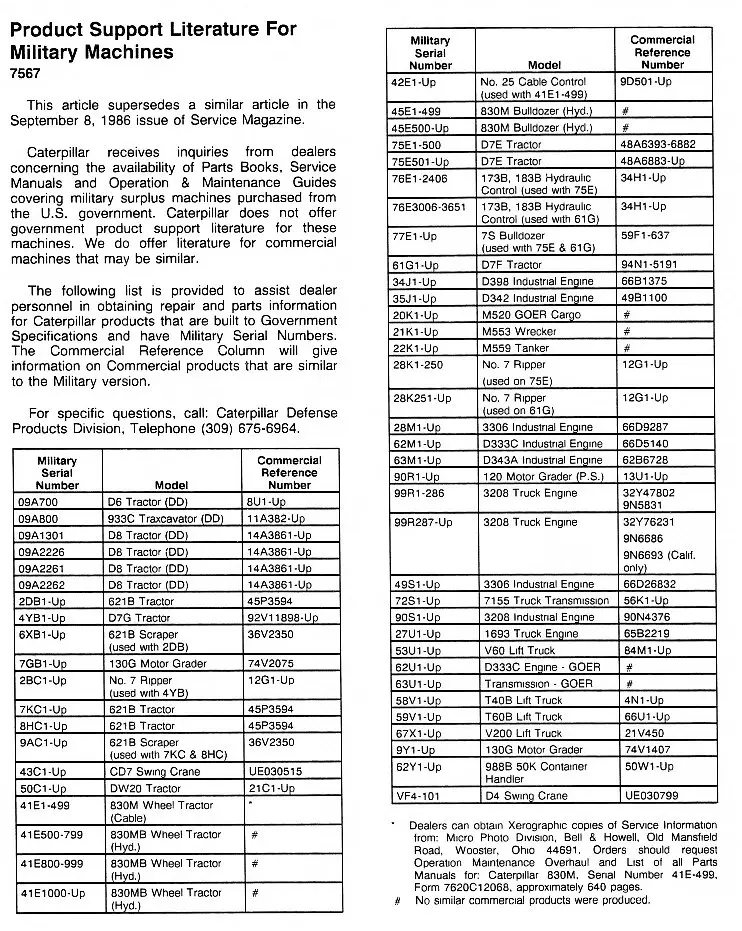All 47A D7E's were set at 1200 rpm high idle. The 160hp 47A's or 75E's were 1335 =-30 rpm high idle. You should be good at 1200rpm. Just remember the hour meter shaft turns half engine speed when checking with a mechanical tach. Depending on your engine the rack settings very also.
Not sure what you are asking. Are you looking for the original high hp settings or reduced settings such as maybe the Industrial engine settings at about 119 hp @ 1200 rpm.

Hi Team,
from my old Rack Setting book it says that 17A1 to 11878 were 1310 RPM High Idle with 123 BHP, and later 17A11879-up were 1310 RPM and 141BHP.
Only because the 47A S/No was mentioned above I offer the following.
47A1 to 3395 were 1315 +/- 30 RPM High Idle and 166 BHP.
47A3396 to 3677 were 1335 +/- 30 RPM RPM High Idle with 173 BHP.
47A3678-up were 1340 +/- 30 RPM and 193 BHP--as far as my book goes for S/No's.
I do not have Rack Settings for Military units, but this equivalent chart shows any D339 powered D7E Military engine would be a 48A Powershift unit as indicated by said chart :-
75E1 to 500 = 48A6393 to 6882, were 1335 +/- 30 RPM and 173 BHP
75E501-up = 48A6883-up, were 1340 +/- 30 RPM and 193BHP.
Hope this helps.
I would need to copy and post a page from my Rack Chart for the relevant turbos, rack settings and torque spring groups as it is technical and I do not know if it would be allowed.
Maybe still not answered your query but backing off or upping the RPM to what you require but still below the numbers given here may not get full power from your engine but would be easier on the 17A drive line than that for a full blooded D7E Powershift engine setting. Rack setting would need to be reduced for best longevity.
An idea of the BHP and RPM you require may be achieved by using one of the altitude de-rate settings for the Military engine.
Cheers,
Eddie B.
Thank you VERY Much I have never had access to a rack setting book. that tractor was serial no 19172 was very late , that engine came direct stat with glow plugs late style turbo so I think 1250 rpm will work fine I don’t want to push her to far, Again thank you! Mike
I still don't get what's going on here. All my rack settings show full load rpm as being 1200 rpm max. Yes, high idle speeds vary. You said the original rpm was to high (1200 rpm) now you want to increase it to 1225 - 1250???
I always thought a 17a was 1200,never did know for sure I do know that d7e engine was running a lot faster when we changed the shims I slowed it down to what I thought a 17a should have been to begin with I am trying to bump it up now without hurting it as all the hill work is in 3rd and gain a little speed , plowing disking and chiseling will not overload the rear end , sorry about the confusion thank you. Mike
Changed the shims? You shouldnt mess with the shims for rpm, just the high idle screw. Do you have a rack setting gauge?
Seems some confusion with you using 1200RPM as a High Idle setting (1200 RPM is the Full Load speed of the 17A --as said above) and others thinking you are meaning 1200 RPM Full Load RPM---these are two different distinct RPM's and Full Load speed is a factor of many variables and is very hard to set on these older governors due to having to use feeler gauges between the torque spring and stop to feel when the rack stop screw is just touching the torque spring--used to be called Balance Point----later engines use an electrical contact to achieve this setting.
The engine needs to be loaded steadily until the balance point is reached and it is dangerous to try and do this on a moving direct drive tractor hence High Idle is given as the adjusted figure for field purposes--then hope Full Load is somewhere close enough to the factory expectation.
High Idle is only ever adjusted by the High Idle screw and Full Load is a design result.
Rack setting is adjusted via shims under the Torque spring assembly, these are usually under its mounting block and so are not the spacer shims between the torque spring and the block--another setting --probably confusing you all but this is why Cat keep this stuff close to their chests as amateurs can easily ruin a good engine and/or cause it to perform below designed parameters--seen this many times over my time at the Dealer.
Cheers,
Eddie B.